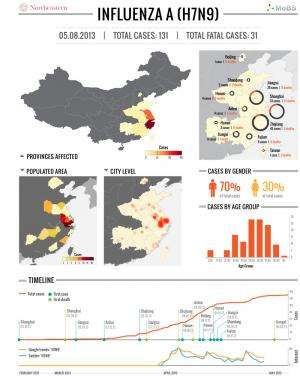What to know about the new bird flu virus

Earlier this month, the U.S. government declared that the emerging H7N9 bird flu "poses a significant potential for a public health emergency." The virus, a relative of other bird flus we've seen previously like H1N1 and H5N1, originated in China and results in a severe respiratory infection and, in some cases, death. While the virus is not, at this time, transmissible between humans, researchers believe that just a few genetic mutations could change that. Network scientist Alessandro Vespignani, the Sternberg Family Distinguished University Professor of physics, computer science, and health sciences, is mapping the disease's progression in his lab. We asked him to discuss the pandemic potential of the virus and explain how this strain differs from those in the past.
How is H7N9 different from other bird flu viruses we've seen in the past?
The H7N9 is a novel reassortant influenza A virus, which very likely originated in birds. However, the transmission of H7 viruses to mammals has seldom been reported, and human infections with N9 subtype viruses had not been documented anywhere in the world before this outbreak. In addition, most of the observed infections are associated with severe symptoms and a high mortality rate. As of today there have been 130 human cases suggesting that the virus appears to be more infectious to people than most of the other avian influenza viruses we know. For instance, in China the feared H5N1 is at the origin of less than 50 cases in one decade. Indeed, it appears that the H7N9 virus shows several mutations that make it more adapted to mammals, and thus humans.
What would it take for H7N9 to become a pandemic threat and how concerned are officials about it reaching that point in the near future?
So far the virus does not have sustained human-to-human transmission. This means that although there have been small family clusters likely triggered by the prolonged exposure to the infectious individual, the virus cannot spread easily in the general population. At the moment it is an infection that people catch from animals, however the circulation among humans may favor further genetic adaptation increasing the transmission potential of the virus. Generally these changes are associated with mild and asymptomatic cases that signal an increased adaptation of the virus to the human host. For this reason, the identification of one asymptomatic case and a few relatively mild cases have raised concerns about the virus. There is an appreciable risk that a pandemic could start if this virus were to change to spread easily between people. The Centers for Disease Control and Prevention, as well as all national and international agencies, are seriously preparing for that possibility.
Based on your modeling projections, what impact do you think the H7N9 strain will have on the global population?
At the moment, the lack of human-to-human transmission makes the spreading pattern of the current outbreak not compatible with any widespread epidemic scenario. It is however possible that isolated cases will be observed in other countries because of travelers from China. If the virus acquires the capability of sustained transmission, the situation would be completely different. In that case it is very likely that the epidemic could escalate to pandemic dimensions in two to three months, as we observed for the H1N1 in 2009. Detailed projections, however, would need specific information on the adapted virus, and the initial pattern of spreading. For this reason it is extremely important to increase and enhance surveillance capabilities not just in China but worldwide. We are in the position to use new digital technologies to monitor the progression of widespread epidemics by tapping into social networks, mobile devices, and web platforms. The next pandemic will be the first one that we will fight not just on the medical frontline but also by using "information intelligence," which will allow us to predict the moves of the biological enemy.













